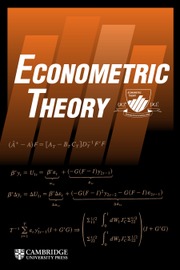No CrossRef data available.
Article contents
ROBUST HIGH-DIMENSIONAL TIME-VARYING COEFFICIENT ESTIMATION
Published online by Cambridge University Press: 16 October 2025
Abstract
In this article, we develop a novel high-dimensional coefficient estimation procedure based on high-frequency data. Unlike usual high-dimensional regression procedures such as LASSO, we additionally handle the heavy-tailedness of high-frequency observations as well as time variations of coefficient processes. Specifically, we employ the Huber loss and a truncation scheme to handle heavy-tailed observations, while  $\ell _{1}$-regularization is adopted to overcome the curse of dimensionality. To account for the time-varying coefficient, we estimate local coefficients which are biased due to the
$\ell _{1}$-regularization is adopted to overcome the curse of dimensionality. To account for the time-varying coefficient, we estimate local coefficients which are biased due to the  $\ell _{1}$-regularization. Thus, when estimating integrated coefficients, we propose a debiasing scheme to enjoy the law of large numbers property and employ a thresholding scheme to further accommodate the sparsity of the coefficients. We call this robust thresholding debiased LASSO (RED-LASSO) estimator. We show that the RED-LASSO estimator can achieve a near-optimal convergence rate. In the empirical study, we apply the RED-LASSO procedure to the high-dimensional integrated coefficient estimation using high-frequency trading data.
$\ell _{1}$-regularization. Thus, when estimating integrated coefficients, we propose a debiasing scheme to enjoy the law of large numbers property and employ a thresholding scheme to further accommodate the sparsity of the coefficients. We call this robust thresholding debiased LASSO (RED-LASSO) estimator. We show that the RED-LASSO estimator can achieve a near-optimal convergence rate. In the empirical study, we apply the RED-LASSO procedure to the high-dimensional integrated coefficient estimation using high-frequency trading data.
Information
- Type
- ARTICLES
- Information
- Creative Commons
- This is an Open Access article, distributed under the terms of the Creative Commons Attribution licence ((https://creativecommons.org/licenses/by/4.0), which permits unrestricted re-use, distribution and reproduction, provided the original article is properly cited.
- Copyright
- © The Author(s), 2025. Published by Cambridge University Press
Footnotes
The research of M.S. was supported in part by the National Research Foundation of Korea (NRF) grant funded by the Korean government (MSIT) (RS-2025-24535699), and in part by the Institute of Information & Communications Technology Planning & Evaluation (IITP)-Global Data-X Leader HRD program grant funded by the Korean government (MSIT) (IITP-2025-RS-2024-00441244). The research of D.K. was supported in part by the National Research Foundation of Korea (NRF) grant funded by the Korean government (MSIT) (RS-2024-00343129).

